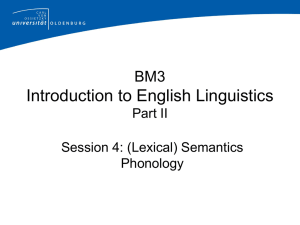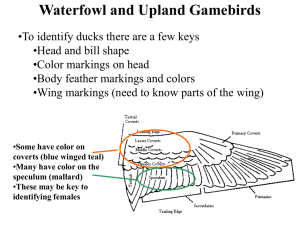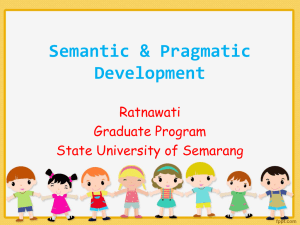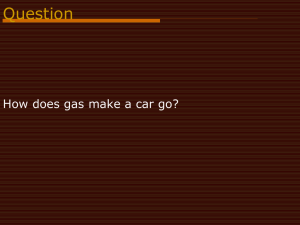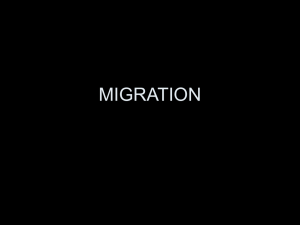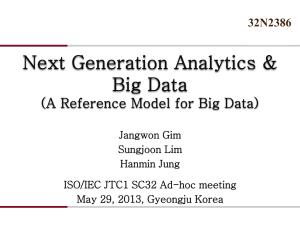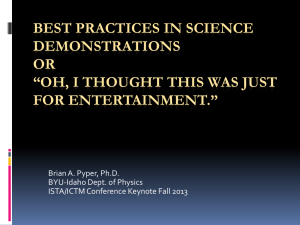Learning to Interpret Natural Language Instructions
advertisement
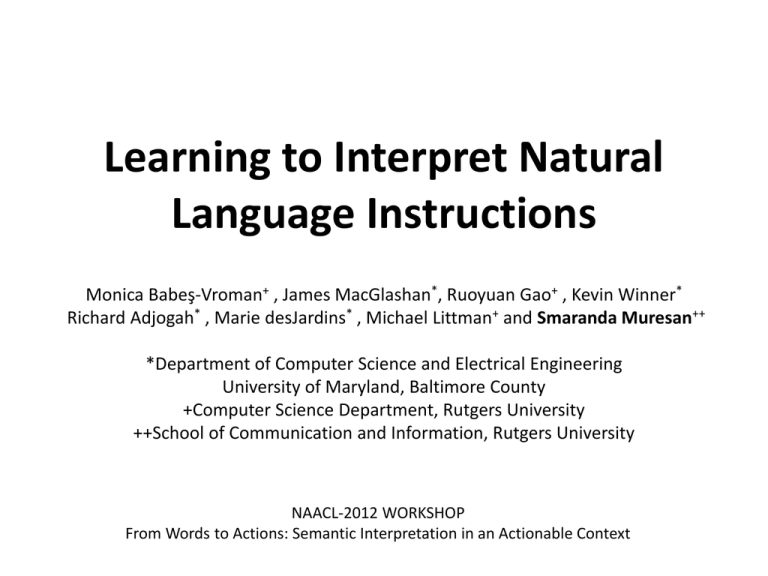
Learning to Interpret Natural Language Instructions Monica Babeş-Vroman+ , James MacGlashan*, Ruoyuan Gao+ , Kevin Winner* Richard Adjogah* , Marie desJardins* , Michael Littman+ and Smaranda Muresan++ *Department of Computer Science and Electrical Engineering University of Maryland, Baltimore County +Computer Science Department, Rutgers University ++School of Communication and Information, Rutgers University NAACL-2012 WORKSHOP From Words to Actions: Semantic Interpretation in an Actionable Context Outline • • • • Motivation and Problem Our approach Pilot study Conclusions and future work Motivation Bring me the red mug that I left in the conference room Motivation Motivation Problem Train an artificial agent to learn to carry out complex multistep tasks specified in natural language. Abstract task: move obj to color room move square to red room Another Example of A Task of pushing an object to a room. Ex : square and red room move star to green room go to green room Outline • • • • What is the problem? Our approach Pilot study Conclusions and future work Training Data: S2 S3 S1 S4 F1 F2 F3 F4 F5 F6 Object-oriented Markov Decision Process (OO-MDP) [Diuk et al., 2008] “Push the star into the teal room” Our Approach “Push the star into the teal room” Task Learning from Demonstrations Semantic Parsing push(star1, room1) P1(room1, teal) F1 F2 F3 F4 F5 F6 Task Abstraction F2 F6 Our Approach “Push the star into the teal room” Task Learning from Demonstrations Semantic Parsing push(star1, room1) P1(room1, teal) “teal” P1 color “push“ objToRoom Task Abstraction F2 F6 Our Approach “Push the star into the teal room” Semantic Parsing Task Abstraction Task Learning from Demonstrations Task Learning from Demonstration = Inverse Reinforcement Learning (IRL) • But first let’s see Reinforcement Learning Problem S2 S3 S1 S4 MDP (S, A, T, γ) R π* RL S2 0% 100% S3 100% S1 30% 70% 0% S4 0% 0% Task Learning From Demonstrations • Inverse Reinforcement Learning S2 0% 100% S3 100% S1 30% 70% πE 0% S4 0% 0% Task Learning From Demonstrations • Inverse Reinforcement Learning S2 0% 100% S3 100% S1 30% 70% πE 0% S4 0% 0% Task Learning From Demonstrations • Inverse Reinforcement Learning S2 S3 S1 S4 MDP (S, A, T, γ) R IRL S2 0% 100% S3 100% S1 30% 70% πE 0% S4 0% 0% MLIRL • Maximum Likelihood IRL [M. Babeş, V. Marivate, K. Subramanian and M. Littman 2011] Assumption: Reward function is a linear combination of a known set of features. (e.g., ) R( s , a ) ( s , a ) ( s , a ) i i i Goal: Find θ to maximize the probability of the observed trajectories. θ φ R Boltzmann Distribution π update in the direction of ∇ Pr( Pr( ) ) (s,a): (state, action) pair R: reward function φ: feature vector π: policy Pr( ): probability of demonstrations Our Approach “Push the star into the teal room” Semantic Parsing Task Abstraction Task Learning from Demonstrations Semantic Parsing • Lexicalized Well-Founded Grammars (LWFG) [Muresan, 2006; 2008; 2012] Semantic model (ontology) Grammar NP (w, NP (w, … ) → Adj (w1, ) → Det (w1, ), NP (w2, ), NP (w2, ): Φi ): Φi Syntax + Semantics + Ontological Constraints text P A R S I N G Semantic representation Semantic Parsing • Lexicalized Well-Founded Grammars (LWFG) [Muresan, 2006; 2008; 2012] Grammar NP (w, NP (w, … ) → Adj (w1, ) → Det (w1, teal room P A R S I N G ), NP (w2, ), NP (w2, ): Φi ): Φi Empty Semantic model room1 X1.is=teal, X.P1=X1, X.isa=room ≅ P1 teal uninstantiated variable Semantic Parsing • Lexicalized Well-Founded Grammars (LWFG) [Muresan, 2006; 2008; 2012] Semantic model (ontology) Grammar NP (w, NP (w, … ) → Adj (w1, ) → Det (w1, ), NP (w2, ), NP (w2, ): Φi ): Φi Syntax/Semantics/Ontological Constraints teal room P A R S I N G room1 X1.is=green, X.color=X1, X.isa=room ≅ color green Learning LWFG • [Muresan and Rambow 2007; Muresan, 2010; 2011] Currently learning is done offline No assumption of existing semantic model Small Training Data Representative Examples NP (loud noise, ) NP (the noise, ) PP … Generalization Set NP NP (loud noise) (the noise) NP (loud clear noise) NP (the loud noise) … RELATIONAL LEARNING MODEL LWFG NP (w, NP (w, … ) → Adj (w1, ) → Det (w1, ), NP (w2, ), NP (w2, ):Φi ):,Φi Using LWFG for Semantic Parsing • Obtain representation with same underlying meaning despite different syntactic forms “go to the green room” vs “go to the room that is green” –Dynamic Semantic Model Can start with an empty semantic model Augmented based on feedback from the TA component push blockToRoom, teal green Our Approach “Push the star into the teal room” Semantic Parsing Task Abstraction Task Learning from Demonstrations Task Abstraction • Creates an abstract task to represent a set of similar grounded tasks – Specifies goal conditions and reward function in terms of OO-MDP propositional functions • Combines information from SP and IRL and provides feedback to both – Provides SP domain specific semantic information – Provides IRL relevant features Similar Grounded Tasks Goal Condition objectIn(o2, l1) Other Terminal Facts isSquare(o2) isYellow(o2) isRed(l1) isGreen(l2) agentIn(o46, l2) … Goal Condition objectIn(o15, l2) Other Terminal Facts isStar(o15) isYellow(o15) isGreen(l2) isRed(l3) objectIn(o31, l3) … Some grounded tasks are similar in logical goal conditions, but different in object references and facts about those referenced objects Abstract Task Definition • Define task conditions as a partial first order logic expression o Ob l L Ob o jec ( o ca ) • The expression takes propositional function parameters to complete it o Object, l Location Obje ( o , l ) isYellow o ) is o ) Star( isGr l ) System Structure Semantic Parsing Inverse Reinforcement Learning (IRL) Task Abstraction Pilot Study Unigram Language Model Data: (Si, Ti). Hidden Data: zji : Pr(Rj | (Si, Ti) ). Parameters: xkj : Pr(wk | Rj ). Pilot Study Unigram Language Model Data: (Si, Ti). Hidden Data: zji : Pr(Rj | (Si, Ti) ). Parameters: xkj : Pr(wk | Rj ). Pr(“push”|R1) ... Pr(“room”|R1) Pr(“push”|R2) ... Pr(“room”|R2) Pilot Study New Instruction, SN : “Go to the green room.” 7 Pr( S | R ) Pr( w | R ) 8 . 6 10 , k 1 N 1 w S k N 4 Pr( S |R ) Pr( w ) 4 . 1 10 N 2 k|R 2 w S k N Pr(“push”|R1) ... Pr(“room”|R1) Pr(“push”|R2) ... Pr(“room”|R2) Pilot Study New Instruction, S’N : “Go with the star to green.” 7 Pr( S 'N |R ) Pr( w | R ) 8 . 3 10 , 1 k 1 w S 'N k 5 Pr( S 'N |R ) Pr( w ) 2 . 1 10 2 k|R 2 w S 'N k Pr(“push”|R1) ... Pr(“room”|R1) Pr(“push”|R2) ... Pr(“room”|R2) Outline • • • • What is the problem? Our approach Pilot study Conclusions and future work Conclusions • Proposed new approach for training an artificial agent to learn to carry out complex multistep tasks specified in natural language, from pairs of instructions and demonstrations • Showed pilot study with a simplified model Current/Future Work • SP, TA and IRL integration • High-level multistep tasks • Probabilistic LWFGs – Probabilistic domain (semantic) model – Learning/Parsing algorithms with both hard and soft constraints • TA – add support for hierarchical task definitions that can handle temporal conditions • IRL – find a partitioning of the execution trace where each partition has it own reward function Thank you!
